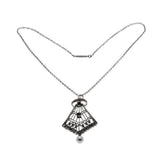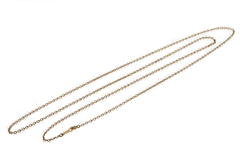Gracious Living - Edwardian Sterling Silver Pearl & Paste Pendant & Chain (EDP029)
Rarities Antique Jewelry
Gracious Living - Edwardian Sterling Silver Pearl & Paste Pendant & Chain. This wonderful pendant is crafted from sterling silver, tested. The pendant features one genuine pearl, numerous round cut paste gemstones, Edwardian era styling, and quality craftsmanship. This exquisite pendant is comprised of a kite shaped filigree frame, which is adorned by clear sparkling paste gems, and a central pink sapphire paste (antique glass) gem. The gallery supports a wonderful white pearl dangle, which adds movement to the piece. The surmount is crescent shaped, which is enhanced by paste gems. The necklace is sterling silver, which is made in an antique belcher design. The chain features its original cylinder clasp, which is in perfect working order. This Edwardian era pendant would make a perfect addition to any antique jewelry collection.
Note: This pendant is elegant, and looks stunning when worn, since the filigree work acts in making a perfect backdrop against your skin, or clothing. Exquisite piece.
History: Pearls were presented as gifts to Chinese royalty as early as 2300 BC, while in ancient Rome, pearl jewellery was considered the ultimate status symbol. So precious were the spherical gems that in the 1st century BC, Julius Caesar passed a law limiting the wearing of pearls only to the ruling classes.
In antique jewellery, lead glass was most commonly used, since the denser the material, the higher the refractive index and the greater the dispersion. Paste jewellery dates back to France during the 18th century when a jeweller named Georges Frederic Stras began hand crafting fine-quality Paste jewellery in 1724.
The story of silver mining began about 5,000 years ago. Silver was first mined around 3,000 BCE in Anatolia, now located in modern-day Turkey. The precious metal helped early civilizations in the Near East, Ancient Greece to flourish.
The term sterling silver denotes any silver alloy in which pure silver makes up at least 92.5 percent of the content. One theory is that the word sterling comes from the name Easterlings—coiners from east German states brought to England during the reign of Henry II (1154–89) to improve the quality of the coinage.
By about the 12th century in England, silver coins were called "Easterlings," a word later abbreviated to "sterling." In 1300, King Edward I made the definition official by declaring that sterling silver had to be 92.5 percent pure silver and should be marked by "guardians of the craft."
In the United Kingdom, the Edwardian era was a period in the early 20th century, that spanned the reign of King Edward VII from 1901 to 1910.
Measurements: Pendant 60.00 mm x 26.50 mm Chain 18"
Stone Size: Pearl 5.00 mm Paste: 1.20 mm - 3.00 mm
Weight: 6.90 grams
Condition: Excellent
Origin: Germany
Date: Circa 1910


















